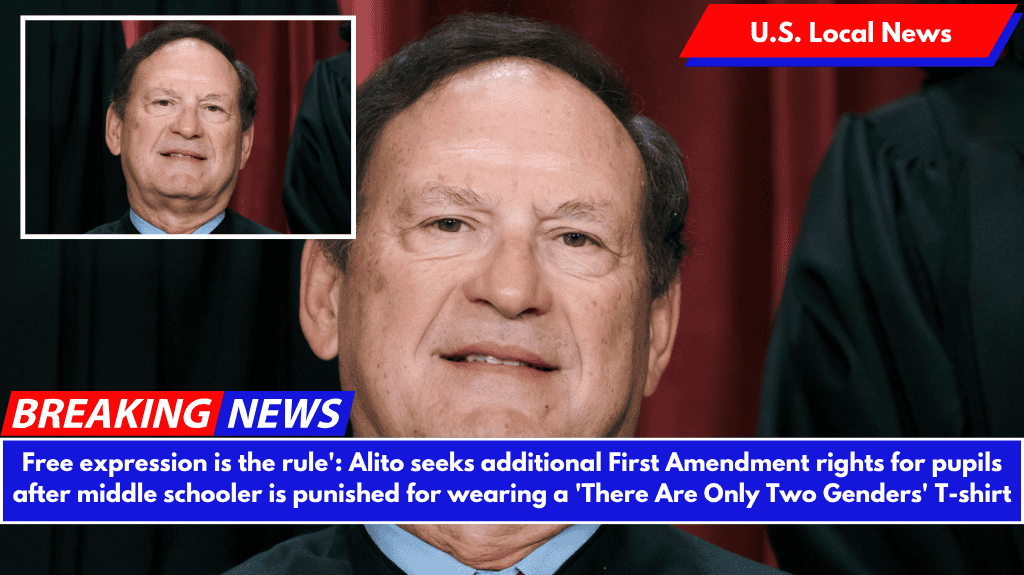Justice Samuel Alito defended “controversial, offensive, or disfavored views” in a case involving a Massachusetts middle school student who was punished for wearing a T-shirt with political messages.
Dissenting from the denial of the petition for writ of certiorari in Morrison v. Town of Middleborough, the justice chastised his colleagues for allowing “confusion” to “linger” over the proper application of long-standing First Amendment case law.
In the case, Liam Morrison, a 7th grader at the time, protested his school’s LGBTQ Pride day by wearing a T-shirt that read “There Are Only Two Genders” to class and was immediately sent home.
In the following days, more protesters and counterprotesters joined the fight, but they remained outside the school grounds. Morrison was punished by administrators again when he returned to school wearing the T-shirt with the word “CENSORED” taped over “Only Two”.
The student sued on First Amendment grounds and lost in both the district and appellate courts. In rejecting his petition, the United States Supreme Court upholds the First Circuit’s ruling in favor of the school.
Alito views the court’s decision as an affront to free speech and a missed opportunity to reiterate and clarify First Amendment doctrine as it relates to the rights of public school children.
In the dispute, all sides agree that the controlling case is Tinker v. Des Moines, a landmark 1968 decision involving a group of anti-Vietnam War students who were sanctioned for wearing black protest armbands to their public school.
The high court, on the other hand, chastised the school district and affirmed the notion that students’ free speech rights are not waived when they enter school, while also giving administrators some leeway to censor student speech that “materially and substantially interferes” with instruction.
The main question is whether Morrison’s treatment at Nichols Middle School (NMS) was consistent with the Tinker framework. According to Alito, the school—and the reviewing courts—went above and beyond.
“The First Circuit held that the school did not violate L.M.’s free-speech rights,” according to the dissent. “It ruled that the general prohibition on viewpoint-based censorship does not apply in public schools.
And it applied a vague, permissive, and jargon-laden rule that differed from the standard set by this Court in Tinker v. Des Moines.”
According to Alito, Morrison was attempting to “register his dissent and start a dialogue on the topic” of gender identity—a viewpoint that the school in question allegedly enforces.
“NMS promotes the view that gender is a fluid construct and that a person’s self-defined identity — not biological sex — determines whether that person is male, female, or something else,” according to Alito.
Morrison, of course, rejects that viewpoint, but he is not the only student who has worn a T-shirt expressing an opinion on the central issue.
Following the suspension, the student’s father called to complain, pointing out that the school, in a social media post, appeared to endorse a position on gender identity by sharing an image of a student wearing a T-shirt reading: “HE SHE THEY IT’S ALL OKAY.”
The superintendent of the school district argued that Morrison’s T-shirt violated the dress code by “target[ing] students of a protected class; namely, in the area of gender identity.”
Here, Alito sees hypocrisy and danger: the government is restricting expression “because of its message.” According to him, “these freedom-of-speech harms become ‘all the more blatant’ when the government ‘targets not subject matter, but particular views taken by speakers on a subject.'” Furthermore, the justice notes that there is no “carveout from this principle for controversial, offensive, or disfavored views.”
The district court ruled against Morrison, finding that he violated “the rights of others.” Later, the appeals court determined that his T-shirt caused a material disruption because it “demean[ed] characteristics of personal identity, such as race, sex, religion, or sexual orientation” that “other students at the school share.”
Alito dismisses this interpretation of Tinker as “a novel and permissive test that distorts the’material disruption’ rule beyond recognition.”
“The First Circuit identified a special category of speech, i.e., speech that can be interpreted as demeaning a deeply rooted characteristic of personal identity,” Alito tells me. “And if student speech, as interpreted by the school, falls into this category, the school may prohibit that speech if the school’reasonably forecast[s]’ that it may have a’serious negative psychological impact on students with the demeaned characteristic.’ “This rule cannot be squared with Tinker.”
Morrison and his T-shirt, according to Alito, are similar to the Tinker students and their black armbands because the school was targeting disfavored speech that irritated some students while allowing majoritarian beliefs on hot topics to be expressed without consequence.
From the dissent, in length:
NMS had no right to censor L.M. Like the black armbands in Tinker, L. M.’s shirts were a “silent, passive expression of opinion, unaccompanied by any disorder or disturbance on the part of petitione[r].” And just as in Tinker, some of L.M.’s classmates found his speech upsetting. Feeling upset, however, is an unavoidable part of living in our “often disputatious” society, and Tinker made abundantly clear that the “mere desire to avoid the discomfort and unpleasantness that always accompany an unpopular viewpoint” is no reason to thwart a student’s speech.
…
The black armbands in that case also involved an emotionally charged topic, and the students in the Des Moines public schools were not somehow immune from those intense feelings.
The school, for its part, was concerned Morrison’s T-shirt would spark a “standoff” between students who support gender identity and those who oppose it.
Alito dismisses this argument as diametrically opposed to Tinker, in which the Supreme Court rejected evidence of “hostile remarks” between students and one math class being “wrecked” by discussion of the Vietnam War as a sufficient disruption to justify censorship.
“Tinker’s ‘material disruption’ standard is demanding by design,” asserts Alito further. “That’s because free speech is the norm, not the exception.” The First Circuit’s test turns that principle on its head.
In its decision, the First Circuit drew attention to the fact that Morrison’s T-shirt was worn to middle school, where students range in age from 10 to 14 years old, arguing that the younger age of the students involved should give administrators more leeway in controlling student speech.
Again, Alito sees a break from Tinker, in which the lead plaintiff, Mary Beth Tinker, was 13 years old.
Alito uses this opportunity to advocate for even stronger free speech protections in the name of ideological diversity.
“If a school sees fit to instruct students of a certain age on a social issue like LGBTQ+ rights or gender identity, then the school must tolerate dissenting student speech on those issues,” the Supreme Court judge writes.
If anything, viewpoint discrimination in the lower grades is more offensive because young children are more impressionable and thus more vulnerable to indoctrination.”
In a concurrence, Justice Clarence Thomas joins Alito.
While Thomas makes it clear that he rejects Tinker itself — over general opposition to free speech for students in grade school in favor of the in loco parentis doctrine — he claims that the lower court decision “flouts Tinker and its progeny” because Morrison and his T-shirt “plainly did not create a’materia[l] disrupt[ion].'”











